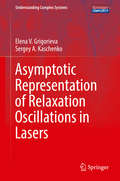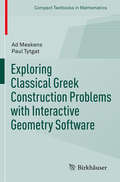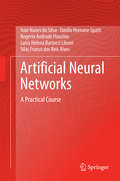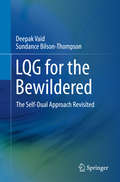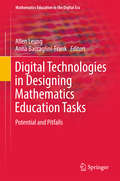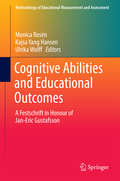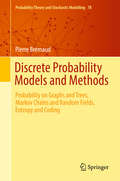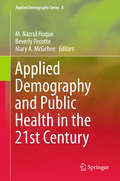- Table View
- List View
Memorized Discrete Systems and Time-delay (Nonlinear Systems and Complexity #17)
by Albert C. LuoThis book examines discrete dynamical systems with memory—nonlinear systems that exist extensively in biological organisms and financial and economic organizations, and time-delay systems that can be discretized into the memorized, discrete dynamical systems. It book further discusses stability and bifurcations of time-delay dynamical systems that can be investigated through memorized dynamical systems as well as bifurcations of memorized nonlinear dynamical systems, discretization methods of time-delay systems, and periodic motions to chaos in nonlinear time-delay systems.The book helps readers find analytical solutions of MDS, change traditional perturbation analysis in time-delay systems, detect motion complexity and singularity in MDS; and determine stability, bifurcation, and chaos in any time-delay system.
Positive Operator Semigroups: From Finite to Infinite Dimensions (Operator Theory: Advances and Applications #257)
by András Bátkai Marjeta Kramar Fijavž Abdelaziz RhandiThis book gives a gentle but up-to-date introduction into the theory of operator semigroups (or linear dynamical systems), which can be used with great success to describe the dynamics of complicated phenomena arising in many applications. Positivity is a property which naturally appears in physical, chemical, biological or economic processes. It adds a beautiful and far reaching mathematical structure to the dynamical systems and operators describing these processes. In the first part, the finite dimensional theory in a coordinate-free way is developed, which is difficult to find in literature. This is a good opportunity to present the main ideas of the Perron-Frobenius theory in a way which can be used in the infinite dimensional situation. Applications to graph matrices, age structured population models and economic models are discussed. The infinite dimensional theory of positive operator semigroups with their spectral and asymptotic theory is developed in the second part. Recent applications illustrate the theory, like population equations, neutron transport theory, delay equations or flows in networks. Each chapter is accompanied by a large set of exercises. An up-to-date bibliography and a detailed subject index help the interested reader. The book is intended primarily for graduate and master students. The finite dimensional part, however, can be followed by an advanced bachelor with a solid knowledge of linear algebra and calculus.
Asymptotic Representation of Relaxation Oscillations in Lasers (Understanding Complex Systems)
by Elena V. Grigorieva Sergey A. KaschenkoIn this book we analyze relaxation oscillations in models of lasers with nonlinear elements controlling light dynamics. The models are based on rate equations taking into account periodic modulation of parameters, optoelectronic delayed feedback, mutual coupling between lasers, intermodal interaction and other factors. With the aim to study relaxation oscillations we present the special asymptotic method of integration for ordinary differential equations and differential-difference equations. As a result, they are reduced to discrete maps. Analyzing the maps we describe analytically such nonlinear phenomena in lasers as multistability of large-amplitude relaxation cycles, bifurcations of cycles, controlled switching of regimes, phase synchronization in an ensemble of coupled systems and others. The book can be fruitful for students and technicians in nonlinear laser dynamics and in differential equations.
Exploring Classical Greek Construction Problems with Interactive Geometry Software (Compact Textbooks in Mathematics)
by Ad Meskens Paul TytgatIn this book the classical Greek construction problems are explored in a didactical, enquiry based fashion using Interactive Geometry Software (IGS). The book traces the history of these problems, stating them in modern terminology. By focusing on constructions and the use of IGS the reader is confronted with the same problems that ancient mathematicians once faced. The reader can step into the footsteps of Euclid, Viète and Cusanus amongst others and then by experimenting and discovering geometric relationships far exceed their accomplishments. Exploring these problems with the neusis-method lets him discover a class of interesting curves.By experimenting he will gain a deeper understanding of how mathematics is created. More than 100 exercises guide him through methods which were developed to try and solve the problems. The exercises are at the level of undergraduate students and only require knowledge of elementary Euclidean geometry and pre-calculus algebra. It is especially well-suited for those students who are thinking of becoming a mathematics teacher and for mathematics teachers.
Operations Research Proceedings 2015: Selected Papers of the International Conference of the German, Austrian and Swiss Operations Research Societies (GOR, ÖGOR, SVOR/ASRO), University of Vienna, Austria, September 1-4, 2015 (Operations Research Proceedings)
by Karl Franz Dörner Ivana Ljubic Georg Pflug Gernot TraglerThis book gathers a selection of refereed papers presented at the “International Conference on Operations Research OR2015,” which was held at the University of Vienna, Austria, September 1-4, 2015. Over 900 scientists and students from 50 countries attended this conference and presented more than 600 papers in parallel topic streams as well as special award sessions. Though the guiding theme of the conference was “Optimal Decision and Big Data,” this volume also includes papers addressing practically all aspects of modern Operations Research.
Soft Methods for Data Science (Advances in Intelligent Systems and Computing #456)
by Maria Brigida Ferraro Paolo Giordani Barbara Vantaggi Marek Gagolewski María Ángeles Gil Przemysław Grzegorzewski Olgierd HryniewiczThis proceedings volume is a collection of peer reviewed papers presented at the 8th International Conference on Soft Methods in Probability and Statistics (SMPS 2016) held in Rome (Italy). The book is dedicated to Data science which aims at developing automated methods to analyze massive amounts of data and to extract knowledge from them. It shows how Data science employs various programming techniques and methods of data wrangling, data visualization, machine learning, probability and statistics. The soft methods proposed in this volume represent a collection of tools in these fields that can also be useful for data science.
Deep Learning and Convolutional Neural Networks for Medical Image Computing: Precision Medicine, High Performance and Large-Scale Datasets (Advances in Computer Vision and Pattern Recognition)
by Le Lu Yefeng Zheng Gustavo Carneiro Lin YangThis book presents a detailed review of the state of the art in deep learning approaches for semantic object detection and segmentation in medical image computing, and large-scale radiology database mining. A particular focus is placed on the application of convolutional neural networks, with the theory supported by practical examples. Features: highlights how the use of deep neural networks can address new questions and protocols, as well as improve upon existing challenges in medical image computing; discusses the insightful research experience of Dr. Ronald M. Summers; presents a comprehensive review of the latest research and literature; describes a range of different methods that make use of deep learning for object or landmark detection tasks in 2D and 3D medical imaging; examines a varied selection of techniques for semantic segmentation using deep learning principles in medical imaging; introduces a novel approach to interleaved text and image deep mining on a large-scale radiology image database.
Ergodic Theory and Negative Curvature: CIRM Jean-Morlet Chair, Fall 2013 (Lecture Notes in Mathematics #2164)
by Boris HasselblattFocussing on the mathematics related to the recent proof of ergodicity of the (Weil–Petersson) geodesic flow on a nonpositively curved space whose points are negatively curved metrics on surfaces, this book provides a broad introduction to an important current area of research. It offers original textbook-level material suitable for introductory or advanced courses as well as deep insights into the state of the art of the field, making it useful as a reference and for self-study. The first chapters introduce hyperbolic dynamics, ergodic theory and geodesic and horocycle flows, and include an English translation of Hadamard's original proof of the Stable-Manifold Theorem. An outline of the strategy, motivation and context behind the ergodicity proof is followed by a careful exposition of it (using the Hopf argument) and of the pertinent context of Teichmüller theory. Finally, some complementary lectures describe the deep connections between geodesic flows in negative curvature and Diophantine approximation.
Artificial Neural Networks: A Practical Course
by Ivan Nunes da Silva Danilo Hernane Spatti Rogerio Andrade Flauzino Luisa Helena Liboni Silas Franco dos Reis AlvesThis book provides comprehensive coverage of neural networks, their evolution, their structure, the problems they can solve, and their applications. The first half of the book looks at theoretical investigations on artificial neural networks and addresses the key architectures that are capable of implementation in various application scenarios. The second half is designed specifically for the production of solutions using artificial neural networks to solve practical problems arising from different areas of knowledge. It also describes the various implementation details that were taken into account to achieve the reported results. These aspects contribute to the maturation and improvement of experimental techniques to specify the neural network architecture that is most appropriate for a particular application scope. The book is appropriate for students in graduate and upper undergraduate courses in addition to researchers and professionals.
LQG for the Bewildered: The Self-Dual Approach Revisited
by Deepak Vaid Sundance Bilson-ThompsonThis primer offers a concise introduction to Loop Quantum Gravity (LQG) - a theoretical framework for uniting Quantum Mechanics (QM) with General Relativity (GR). The emphasis is on the physical aspects of the framework and its historical development in terms of self-dual variables, still most suited for a first, pedagogical encounter with LQG. The text starts by reviewing GR and the very basics of Quantum Field Theory (QFT), and then explains in a concise and clear manner the steps leading from the Einstein-Hilbert action for gravity to the construction of the quantum states of geometry, known as spin-networks, and which provide the basis for the kinematical Hilbert space of quantum general relativity. Along the way the various associated concepts of tetrads, spin-connection and holonomies are introduced. Having thus provided a minimal introduction to the LQG framework, some applications to the problems of black hole entropy and of quantum cosmology are briefly surveyed. Last but not least, a list of the most common criticisms of LQG is presented, which are then tackled one by one in order to convince the reader of the physical viability of the theory. A set of appendices provides accessible introductions to several key notions such as the Peter-Weyl theorem, duality of differential forms and Regge calculus, among others. The presentation is aimed at graduate students and researchers who have some familiarity with the tools of QM and GR, but are intimidated by the technicalities required to browse through the existing LQG literature. This primer aims at making the formalism appear a little less bewildering to the uninitiated and helps lower the barrier for entry into the field.
Elements of Nonlinear Time Series Analysis and Forecasting (Springer Series in Statistics)
by Jan G. De GooijerThis book provides an overview of the current state-of-the-art of nonlinear time series analysis, richly illustrated with examples, pseudocode algorithms and real-world applications. Avoiding a “theorem-proof” format, it shows concrete applications on a variety of empirical time series. The book can be used in graduate courses in nonlinear time series and at the same time also includes interesting material for more advanced readers. Though it is largely self-contained, readers require an understanding of basic linear time series concepts, Markov chains and Monte Carlo simulation methods.The book covers time-domain and frequency-domain methods for the analysis of both univariate and multivariate (vector) time series. It makes a clear distinction between parametric models on the one hand, and semi- and nonparametric models/methods on the other. This offers the reader the option of concentrating exclusively on one of these nonlinear time series analysis methods.To make the book as user friendly as possible, major supporting concepts and specialized tables are appended at the end of every chapter. In addition, each chapter concludes with a set of key terms and concepts, as well as a summary of the main findings. Lastly, the book offers numerous theoretical and empirical exercises, with answers provided by the author in an extensive solutions manual.
Computational Probability Applications: Algorithms And Applications In The Mathematical Sciences (International Series in Operations Research & Management Science #247)
by Andrew G. Glen Lawrence M. LeemisThis focuses on the developing field of building probability models with the power of symbolic algebra systems. The book combines the uses of symbolic algebra with probabilistic/stochastic application and highlights the applications in a variety of contexts. The research explored in each chapter is unified by the use of A Probability Programming Language (APPL) to achieve the modeling objectives. APPL, as a research tool, enables a probabilist or statistician the ability to explore new ideas, methods, and models. Furthermore, as an open-source language, it sets the foundation for future algorithms to augment the original code. Computational Probability Applications is comprised of fifteen chapters, each presenting a specific application of computational probability using the APPL modeling and computer language. The chapter topics include using inverse gamma as a survival distribution, linear approximations of probability density functions, and also moment-ratio diagrams for univariate distributions. These works highlight interesting examples, often done by undergraduate students and graduate students that can serve as templates for future work. In addition, this book should appeal to researchers and practitioners in a range of fields including probability, statistics, engineering, finance, neuroscience, and economics.
Computational Probability: Algorithms and Applications in the Mathematical Sciences (International Series in Operations Research & Management Science #246)
by John H. Drew Diane L. Evans Andrew G. Glen Lawrence M. LeemisThis new edition includes the latest advances and developments in computational probability involving A Probability Programming Language (APPL). The book examines and presents, in a systematic manner, computational probability methods that encompass data structures and algorithms. The developed techniques address problems that require exact probability calculations, many of which have been considered intractable in the past. The book addresses the plight of the probabilist by providing algorithms to perform calculations associated with random variables. Computational Probability: Algorithms and Applications in the Mathematical Sciences, 2nd Edition begins with an introductory chapter that contains short examples involving the elementary use of APPL. Chapter 2 reviews the Maple data structures and functions necessary to implement APPL. This is followed by a discussion of the development of the data structures and algorithms (Chapters 3–6 for continuous random variables and Chapters 7–9 for discrete random variables) used in APPL. The book concludes with Chapters 10–15 introducing a sampling of various applications in the mathematical sciences. This book should appeal to researchers in the mathematical sciences with an interest in applied probability and instructors using the book for a special topics course in computational probability taught in a mathematics, statistics, operations research, management science, or industrial engineering department.
The Frontiers of Applied Demography (Applied Demography Series #9)
by David A. SwansonThis book details cutting-edge methods and findings that may shape the future of applied demography. Inside, readers will discover new insights into the databases, substantive issues, and methodological approaches that can help them to improve how they use demography in decision making and planning problems in both public and private settings.The topics and perspectives are found in the book’s 23 chapters, which are organized into three major sections: (I) Demographic Information for Decision-Making: Case Studies; (II) Data: Issues and Analyses; and (III) Projection and Estimation Methods: Evaluations, Examples, and Discussions. Coverage includes chapters on migration, demographic market analysis, future courtroom needs, trends in the needs of the elderly, access to health care, longitudinal data systems, census costs, and new approaches to small area estimation and projection methods. The case studies represent a wide range of countries, including Australia, Canada, China, England, India, Japan, and the United States of America. Overall, this edited volume collects papers that were presented at different conferences, including the 8th international conference on population geographies (University of Queensland, 2015), the 2014 Applied Demography Conference (San Antonio, Texas, USA), and the annual conference of the Canadian Population Society. Applied demography touches many aspects of our lives and its practitioners continue to push methodological and empirical boundaries. This book documents the steady evolution of this field. It shows demographers, sociologists, economists, planners, marketers, and others how they can improve the quality and relevance of demographic information now and in the future.
Data Assimilation for Atmospheric, Oceanic and Hydrologic Applications (Vol. III)
by Seon Ki Park Liang XuThis book contains the most recent progress in data assimilation in meteorology, oceanography and hydrology including land surface. It spans both theoretical and applicative aspects with various methodologies such as variational, Kalman filter, ensemble, Monte Carlo and artificial intelligence methods. Besides data assimilation, other important topics are also covered including targeting observation, sensitivity analysis, and parameter estimation. The book will be useful to individual researchers as well as graduate students for a reference in the field of data assimilation.
Digital Technologies in Designing Mathematics Education Tasks: Potential and Pitfalls (Mathematics Education in the Digital Era #8)
by Allen Leung Anna Baccaglini-FrankThis book is about the role and potential of using digital technology in designing teaching and learning tasks in the mathematics classroom. Digital technology has opened up different new educational spaces for the mathematics classroom in the past few decades and, as technology is constantly evolving, novel ideas and approaches are brewing to enrich these spaces with diverse didactical flavors. A key issue is always how technology can, or cannot, play epistemic and pedagogic roles in the mathematics classroom. The main purpose of this book is to explore mathematics task design when digital technology is part of the teaching and learning environment. What features of the technology used can be capitalized upon to design tasks that transform learners’ experiential knowledge, gained from using the technology, into conceptual mathematical knowledge? When do digital environments actually bring an essential (educationally, speaking) new dimension to classroom activities? What are some pragmatic and semiotic values of the technology used? These are some of the concerns addressed in the book by expert scholars in this area of research in mathematics education. This volume is the first devoted entirely to issues on designing mathematical tasks in digital teaching and learning environments, outlining different current research scenarios.
Cognitive Abilities and Educational Outcomes: A Festschrift in Honour of Jan-Eric Gustafsson (Methodology of Educational Measurement and Assessment)
by Monica Rosén Kajsa Yang Hansen Ulrika WolffThis book addresses problems and challenges that face educational measurement at a time when multipurpose usage of observational data from educational assessments, tests and international surveys has become a growing global trend. While the construction of educational measures and use of educational data offer many opportunities, they also require awareness of the numerous threats to validity and methods of reducing such threats. Written by leading international scholars, the book demonstrates the complexity of educational measurement by addressing three broad and interrelated topics. The first part discusses cognitive abilities, including studies on fluid intelligence, its improvement and its links to aptitude tests for admission to higher education. The second part focuses on the effects of school and teacher-related factors on school outcomes at individual and group levels, and uses international studies to analyze causes. The third part presents analytical techniques and measurement methods to improve reliability, for example factor analysis using Bayesian estimators, bi-factor analysis, model misfit and solutions, and discusses balance issues in reporting test results.The book provides examples of state-of-the-art analytical techniques for pursuing fundamental research problems, and the latest advances in measurement methods, with a focus on validity improvement. Eminent researchers discuss and provide insights into questions such as: Is it possible to train individuals to think at a higher level than normal for their age? What determines prospective preschool teachers’ skill to perceive mathematics-related preschool situations? Can international indicator design and instruments be improved to use trends and national context variables more efficiently? Can indicator data at national, school and class levels be compared easier? Are value-added measures of teacher effectiveness valid when it comes to hiring and promoting teachers? Is money better spent on teacher training than on smaller class-size? How do theory and empirical statistical data intertwine in building structures of understanding? This book is inspired by the career and personal influence of the Swedish scholar Professor Jan-Eric Gustafsson, renowned for his research on individual differences, especially the structure of cognitive abilities, and on the effects of education on knowledge and skills.
Discrete Probability Models and Methods: Probability on Graphs and Trees, Markov Chains and Random Fields, Entropy and Coding (Probability Theory and Stochastic Modelling #78)
by Pierre BrémaudThe emphasis in this book is placed on general models (Markov chains, random fields, random graphs), universal methods (the probabilistic method, the coupling method, the Stein-Chen method, martingale methods, the method of types) and versatile tools (Chernoff's bound, Hoeffding's inequality, Holley's inequality) whose domain of application extends far beyond the present text. Although the examples treated in the book relate to the possible applications, in the communication and computing sciences, in operations research and in physics, this book is in the first instance concerned with theory. The level of the book is that of a beginning graduate course. It is self-contained, the prerequisites consisting merely of basic calculus (series) and basic linear algebra (matrices). The reader is not assumed to be trained in probability since the first chapters give in considerable detail the background necessary to understand the rest of the book.
The Lidov-Kozai Effect - Applications in Exoplanet Research and Dynamical Astronomy (Astrophysics and Space Science Library #441)
by Ivan I. ShevchenkoThis book deals with an effect in celestial mechanics that has become quite important in exoplanet research. The Lidov-Kozai effect reveals itself in coherent periodic variations (which can be very large) of the inclination and eccentricity of an orbiting body in the presence of an inclined perturber. The effect is known to be important in the motion of many asteroids and planetary satellites. What is more, now it attracts more and more interest in the astronomical and astrophysical community due to its relevance for many exoplanetary systems. Recent years witnessed major advancements in its theory. It would be no exaggeration to say that nowadays the Lidov-Kozai effect becomes one of the most studied astrophysical effects. This book covers the multitude of the Lidov-Kozai effect’s modern applications and its theory developments. It will be useful for researchers and students working in astrophysics, celestial mechanics, stellar dynamics, theoretical mechanics, space missions design, depending on the interests of the reader. The book is self-contained. It provides the full detailed coverage of the effect’s theory and applications.
Fundamentals of Statistical Hydrology
by Mauro NaghettiniThis textbook covers the main applications of statistical methods in hydrology. It is written for upper undergraduate and graduate students but can be used as a helpful guide for hydrologists, geographers, meteorologists and engineers. The book is very useful for teaching, as it covers the main topics of the subject and contains many worked out examples and proposed exercises. Starting from simple notions of the essential graphical examination of hydrological data, the book gives a complete account of the role that probability considerations must play during modelling, diagnosis of model fit, prediction and evaluating the uncertainty in model predictions, including the essence of Bayesian application in hydrology and statistical methods under nonstationarity.The book also offers a comprehensive and useful discussion on subjective topics, such as the selection of probability distributions suitable for hydrological variables. On a practical level, it explains MS Excel charting and computing capabilities, demonstrates the use of Winbugs free software to solve Monte Carlo Markov Chain (MCMC) simulations, and gives examples of free R code to solve nonstationary models with nonlinear link functions with climate covariates.
The Statistical Stability Phenomenon (Mathematical Engineering)
by Igor I. GorbanThis monograph investigates violations of statistical stability of physical events, variables, and processes and develops a new physical-mathematical theory taking into consideration such violations – the theory of hyper-random phenomena. There are five parts. The first describes the phenomenon of statistical stability and its features, and develops methods for detecting violations of statistical stability, in particular when data is limited. The second part presents several examples of real processes of different physical nature and demonstrates the violation of statistical stability over broad observation intervals. The third part outlines the mathematical foundations of the theory of hyper-random phenomena, while the fourth develops the foundations of the mathematical analysis of divergent and many-valued functions. The fifth part contains theoretical and experimental studies of statistical laws where there is violation of statistical stability.The monograph should be of particular interest to engineers and scientists in general who study the phenomenon of statistical stability and use statistical methods for high-precision measurements, prediction, and signal processing over long observation intervals.
Turbulence and Dispersion in the Planetary Boundary Layer (Physics of Earth and Space Environments)
by Francesco TampieriThis book offers a comprehensive review of our current understanding of the planetary boundary layer, particularly the turbulent exchanges of momentum, heat and passive scalars between the surface of the Earth and the atmosphere. It presents and discusses the observations and the theory of the turbulent boundary layer, both for homogeneous and more realistic heterogeneous surface conditions, as well as the dispersion of tracers. Lastly it addresses the main problems arising due to turbulence in weather, climate and atmospheric composition numerical models. Written for postgraduate and advanced undergraduate-level students and atmospheric researchers, it is also of interest to anyone wanting to understand the findings and obtain an update on problems that have yet to be solved.
EPFL Lectures on Conformal Field Theory in D ≥ 3 Dimensions (SpringerBriefs in Physics)
by Slava RychkovThis primer develops Conformal Field Theory (CFT) from scratch, whereby CFT is viewed as any conformally-invariant theory that describes a fixed point of a renormalization group flow in quantum field theory.The book is divided into four lectures: Lecture 1 addresses the physical foundations of conformal invariance, while Lecture 2 examines the constraints imposed by conformal symmetry on the correlation functions of local operators, presented using the so-called projective null cone – a procedure also known as the embedding formalism. In turn, Lecture 3 focuses on the radial quantization and the operator product expansion, while Lecture 4 offers a very brief introduction to the conformal bootstrap. Derived from course-based notes, these lectures are intended as a first point of entry to this topic for Master and PhD students alike.
The Incomputable: Journeys Beyond the Turing Barrier (Theory and Applications of Computability)
by S. Barry Cooper Mariya I. SoskovaThis book questions the relevance of computation to the physical universe. Our theories deliver computational descriptions, but the gaps and discontinuities in our grasp suggest a need for continued discourse between researchers from different disciplines, and this book is unique in its focus on the mathematical theory of incomputability and its relevance for the real world. The core of the book consists of thirteen chapters in five parts on extended models of computation; the search for natural examples of incomputable objects; mind, matter, and computation; the nature of information, complexity, and randomness; and the mathematics of emergence and morphogenesis. This book will be of interest to researchers in the areas of theoretical computer science, mathematical logic, and philosophy.
Applied Demography and Public Health in the 21st Century (Applied Demography Series #8)
by M. Nazrul Hoque Beverly Pecotte Mary A. McGeheeThis book demonstrates different statistical techniques for analyzing health-related data as well as providing new techniques for forecasting and/or projecting the incidence of diseases/disorders. It presents information on a variety of health related issues from the developed and developing world. Featuring cutting edge research from distinguished applied demographers and public health specialists, the book bridges the gap between theory and research. Each chapter provides methods and materials that can be used to conduct further research aimed at promoting public health issues. This book is intended for public health professionals, health policy makers, social epidemiologists, administrators, researchers, and students in the fields of applied demography and public health who are interested in exploring the potential of ground-breaking research or who want to further develop their existing research techniques. It complements another volume in the Applied Demography Series, Applied Demography and Public Health (Springer, 2013), which describes how applied demographic techniques can be used to help address public health issues.


